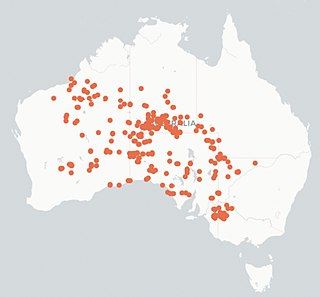The Lancelin Island skink, also known commonly as the Lancelin south-west ctenotus, is a species of skink, a lizard in the family Scincidae. The species is endemic to Australia.

Ctenotus strauchii, also known commonly as the eastern barred wedge-snout ctenotus or Strauch's ctenotus, is a small species of lizard in the family Scincidae. The species is endemic to Australia and is found throughout semi-arid and arid regions in most of Australia's mainland states except Western Australia, although one record does exist for Western Australia in 1975.
Ctenotus alleni, also known commonly as the Ajana ctenotus and Allen's ctenotus, is a species of skink, a lizard in the family Scincidae. The species is endemic to Western Australia.
Ctenotus ariadnae, also known commonly as Ariadna's ctenotus, is a species of skink, a lizard in the family Scincidae. The species is endemic to Australia.
Ctenotus astarte, also known commonly as the stony downs ctenotus, is a species of skink, a lizard in the family Scincidae. The species is endemic to Australia.

Ctenotus brooksi, also known commonly as Brooks' wedge-snouted ctenotus, the wedgesnout ctenotus, and the sandhill ctenotus, is a species of skink, a lizard in the family Scincidae. The species is endemic to Australia and found in semi-arid regions.

Ctenotus burbidgei, also known commonly as the plain-backed Kimberley ctenotus, is a species of skink, a lizard in the family Scincidae. The species is native to Western Australia.
Ctenotus colletti, also known commonly as the buff-tailed finesnout ctenotus, Collett’s ctenotus, and Collett's skink, is a species of lizard in the family Scincidae. The species is endemic to Australia.
Ctenotus delli, also known commonly as the Darling Range south-west ctenotus or the Darling Range southwest ctenotus, is a species of skink, a lizard in the family Scincidae. The species is endemic to Australia.
Ctenotus ehmanni, also known commonly as the brown-tailed finesnout ctenotus or Ehmann's ctenotus, is a species of skink, a lizard in the family Scincidae. The species is endemic to the Australian state of Western Australia.

Ctenotus essingtonii, also known commonly as Essington's ctenotus and the lowlands plain-backed ctenotus, is a species of skink, a lizard in the family Scincidae. The species is endemic to the Northern Territory in Australia.
Ctenotus eurydice, also known commonly as the brown-backed yellow-lined ctenotus, is a species of skink, a lizard in the family Scincidae. The species is native to New South Wales and Queensland in Australia.
Ctenotus greeri, also known commonly as Greer's ctenotus and the spotted-necked ctenotus, is a species of skink, a lizard in the family Scincidae. The species is endemic to Australia.
Ctenotus hanloni, also known commonly as Hanlon's ctenotus and the nimble ctenotus, is a species of skink, a lizard in the family Scincidae. The species is endemic to Australia.
Ctenotus hilli, also known commonly as Hill's ctenotus and the Top-end lowlands ctenotus, is a species of lizard in the subfamily Sphenomorphinae of the family Scincidae (skinks). The species is endemic to the Northern Territory in Australia.
Ctenotus ingrami, also known commonly as Ingram's ctenotus and the unspotted yellow-sided ctenotus, is a species of skink, a lizard in the family Scincidae. The species is native to Queensland and New South Wales in Australia.
Ctenotus joanae, also known commonly as the blacksoil ctenotus and the black-soil ctenotus, is a species of lizard in the subfamily Sphenomorphinae of the family Scincidae (skinks). The species is endemic to Australia.
Ctenotus stuarti, also known commonly as the Point Stuart ctenotus or Stuart's ctenotus, is a species of skink, a lizard in the family Scincidae. The species is endemic to Australia.
Ctenotus youngsoni, also known commonly as the Shark Bay south-west ctenotus and Youngson's ctenotus, is a species of skink, a lizard in the family Scincidae. The species is endemic to Australia. The specific name, youngsoni, is in honour of Australian zoologist William Kenneth Youngson. C. youngsoni is found in the Australian state of Western Australia. The preferred natural habitat of C. youngsoni is shrubland. C. youngsoni has well-developed limbs, with five toes on each of its four feet. C. youngsoni is oviparous.

Ctenotus helenae, also known commonly as the clay-soil ctenotus, is a species of skink, a lizard in the family Scincidae. The species is endemic to Australia.




